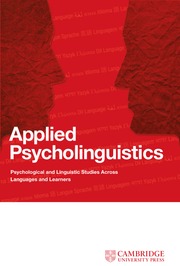Crossref Citations
This article has been cited by the following publications. This list is generated based on data provided by
Crossref.
Rothweiler, Monika
2009.
Critical periods and SLI.
Zeitschrift für Sprachwissenschaft,
Vol. 28,
Issue. 1,
p.
49.
Paradis, Johanne
2009.
Maturation: For better or for worse?.
Zeitschrift für Sprachwissenschaft,
Vol. 28,
Issue. 1,
p.
41.
Rice, Mabel L.
Hoffman, Lesa
and
Wexler, Ken
2009.
Judgments of Omitted BE and DO in Questions as Extended Finiteness Clinical Markers of Specific Language Impairment (SLI) to 15 Years: A Study of Growth and Asymptote.
Journal of Speech, Language, and Hearing Research,
Vol. 52,
Issue. 6,
p.
1417.
PARADIS, JOHANNE
2010.
Response to Commentaries on the interface between bilingual development and specific language impairment.
Applied Psycholinguistics,
Vol. 31,
Issue. 2,
p.
345.
PARADIS, JOHANNE
2010.
The interface between bilingual development and specific language impairment.
Applied Psycholinguistics,
Vol. 31,
Issue. 2,
p.
227.
Marinis, Theodoros
and
Chondrogianni, Vasiliki
2010.
Production of tense marking in successive bilingual children: When do they converge with their monolingual peers?.
International Journal of Speech-Language Pathology,
Vol. 12,
Issue. 1,
p.
19.
Paradis, Johanne
Emmerzael, Kristyn
and
Duncan, Tamara Sorenson
2010.
Assessment of English language learners: Using parent report on first language development.
Journal of Communication Disorders,
Vol. 43,
Issue. 6,
p.
474.
Garrity, April W.
and
Oetting, Janna B.
2010.
Auxiliary BE Production by African American English–Speaking Children With and Without Specific Language Impairment.
Journal of Speech, Language, and Hearing Research,
Vol. 53,
Issue. 5,
p.
1307.
Rice, Mabel L.
2010.
Evaluating maturational parallels in second language children and children with specific language impairment.
Applied Psycholinguistics,
Vol. 31,
Issue. 2,
p.
320.
MCDONALD, JANET L.
and
ROUSSEL, CRISTINE C.
2010.
Past tense grammaticality judgment and production in non-native and stressed native English speakers.
Bilingualism: Language and Cognition,
Vol. 13,
Issue. 4,
p.
429.
Bohman, Thomas M.
Bedore, Lisa M.
Peña, Elizabeth D.
Mendez-Perez, Anita
and
Gillam, Ronald B.
2010.
What you hear and what you say: language performance in Spanish–English bilinguals.
International Journal of Bilingual Education and Bilingualism,
Vol. 13,
Issue. 3,
p.
325.
Paradis, Johanne
2010.
Bilingual Children's Acquisition of English Verb Morphology: Effects of Language Exposure, Structure Complexity, and Task Type.
Language Learning,
Vol. 60,
Issue. 3,
p.
651.
Paradis, Johanne
2011.
Individual differences in child English second language acquisition
.
Linguistic Approaches to Bilingualism,
Vol. 1,
Issue. 3,
p.
213.
Chondrogianni, Vasiliki
and
Marinis, Theodoros
2011.
Differential effects of internal and external factors on the development of vocabulary, tense morphology and morpho-syntax in successive bilingual children.
Linguistic Approaches to Bilingualism,
Vol. 1,
Issue. 3,
p.
318.
García Mayo, María del Pilar
and
Villarreal Olaizola, Izaskun
2011.
The development of suppletive and affixal tense and agreement morphemes in the L3 English of Basque-Spanish bilinguals.
Second Language Research,
Vol. 27,
Issue. 1,
p.
129.
Blom, Elma
and
Vasić, Nada
2011.
The production and processing of determiner–noun agreement in child L2 Dutch.
Linguistic Approaches to Bilingualism,
Vol. 1,
Issue. 3,
p.
265.
Dixon, L. Quentin
Zhao, Jing
Shin, Jee-Young
Wu, Shuang
Su, Jung-Hsuan
Burgess-Brigham, Renata
Gezer, Melike Unal
and
Snow, Catherine
2012.
What We Know About Second Language Acquisition.
Review of Educational Research,
Vol. 82,
Issue. 1,
p.
5.
NICOLADIS, ELENA
SONG, JIANHUI
and
MARENTETTE, PAULA
2012.
Do young bilinguals acquire past tense morphology like monolinguals, only later? Evidence from French–English and Chinese–English bilinguals.
Applied Psycholinguistics,
Vol. 33,
Issue. 3,
p.
457.
CHONDROGIANNI, VASILIKI
and
MARINIS, THEODOROS
2012.
Production and processing asymmetries in the acquisition of tense morphology by sequential bilingual children.
Bilingualism: Language and Cognition,
Vol. 15,
Issue. 1,
p.
5.
Blom, Elma
Paradis, Johanne
and
Duncan, Tamara Sorenson
2012.
Effects of Input Properties, Vocabulary Size, and L1 on the Development of Third Person Singular –s in Child L2 English.
Language Learning,
Vol. 62,
Issue. 3,
p.
965.


